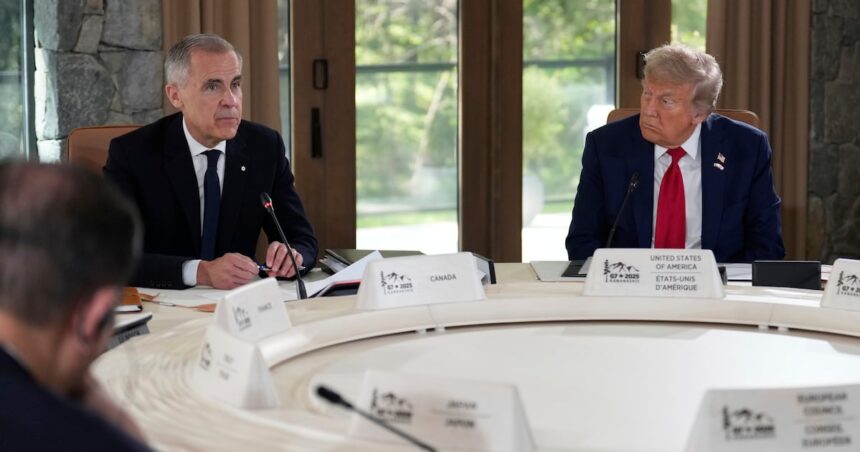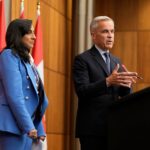Today I watched a curious scene unfold at the Canada-U.S. border crossing in Windsor. Truck drivers, some who’ve made this journey three times weekly for decades, waited in longer-than-usual lines while checking news alerts on their phones. The cause? Mounting anxiety over what might happen to the intricate trade relationship that moves CAD$3 billion in goods across our shared border daily.
As Prime Minister Trudeau and President Biden approach their final scheduled bilateral meeting next month, Canada’s business community holds its collective breath. The stakes couldn’t be higher – our two economies remain profoundly interconnected despite the political turbulence of recent years.
“We’ve weathered NAFTA renegotiations, pandemic disruptions, and supply chain chaos,” explains Maryscott Greenwood, CEO of the Canadian American Business Council. “But this moment feels different with protectionist pressures mounting on both sides of the border.”
The current Canada-U.S. trade relationship operates under the CUSMA framework (known as USMCA in the States), which replaced NAFTA in 2020. While this agreement provided stability following tense negotiations during the Trump administration, several critical provisions face review deadlines in 2024.
According to Statistics Canada, roughly 75% of Canadian exports still head to the United States – a figure that hasn’t shifted significantly despite years of diversification efforts. Meanwhile, American businesses depend on Canadian raw materials, energy resources, and integrated manufacturing.
What’s actually at stake in these talks? Three main pressure points have emerged:
First, “Buy American” provisions continue expanding under the Biden administration’s industrial policy. The Inflation Reduction Act initially excluded Canadian products from critical tax credits, though subsequent negotiations secured limited exemptions for electric vehicle components.
“Canada keeps fighting for recognition as a domestic supplier, but we’re always starting on the back foot,” notes trade lawyer Lawrence Herman of Herman & Associates. “The default American position treats us as foreign, requiring special carve-outs rather than inclusion by design.”
Second, digital trade rules need modernization. When CUSMA was negotiated, concepts like generative AI barely existed. Today, cross-border data flows represent the fastest-growing segment of bilateral commerce.
The Business Council of Canada recently published a report indicating that nearly 40% of Canadian service exports to the U.S. now happen digitally – a dramatic increase from just five years ago. Yet regulatory frameworks remain underdeveloped, particularly around artificial intelligence.
Finally, climate policies create both opportunities and tensions. While both countries have ambitious emissions targets, their approaches differ. Canada’s carbon pricing system contrasts with America’s tax credit and investment approach.
“We’re moving toward the same destination via different vehicles,” explains Catherine McKenna, former Canadian Environment Minister. “The challenge is ensuring these different systems don’t create competitive disadvantages for businesses on either side.”
A particularly thorny issue emerging in preliminary talks involves carbon border adjustments. As Canada prices carbon domestically, concerns grow about competition from jurisdictions without equivalent costs. The European Union has already implemented a Carbon Border Adjustment Mechanism, and Canada is exploring similar measures.
Recent testimony before the House of Commons Trade Committee revealed Canadian officials worry such mechanisms could trigger American retaliation if poorly designed. Meanwhile, American negotiators signal resistance to any mechanism resembling a tariff on U.S. exports.
Inside sources at Global Affairs Canada, speaking on background, acknowledge the diplomatic challenge. “We’re essentially trying to align complex systems that weren’t built to work together, while navigating political sensitivities in both capitals.”
The Bank of Canada estimates trade uncertainty during previous NAFTA renegotiations reduced business investment by approximately 3%. Current indicators suggest similar caution returning to boardrooms across the country.
Michael Froman, former U.S. Trade Representative during the Obama administration, observes that “successful trade relationships require constant maintenance. The mistake both countries sometimes make is taking the relationship for granted until problems arise.”
For small businesses particularly dependent on cross-border commerce, these high-level negotiations translate to immediate concerns. Sarah Richardson owns a specialty food company in Halifax that sources packaging from Michigan while exporting Atlantic seafood products to New England restaurants.
“Every time trade friction increases, my costs go up,” Richardson explains. “It’s not just tariffs – it’s paperwork, delays, and uncertainty that eat into already thin margins.”
The upcoming talks will likely focus on pragmatic improvements rather than dramatic restructuring. Both governments recognize the deep integration of our economies makes radical changes impractical and potentially harmful.
Meanwhile, provincial premiers are playing an increasingly assertive role in the process. Ontario’s Doug Ford and Quebec’s François Legault have both conducted separate trade missions to key U.S. states, emphasizing regional economic partnerships that sometimes bypass federal complexities.
As someone who’s covered Canada-U.S. relations for nearly two decades, I’ve observed how the rhetoric often overshadows reality. Despite periodic tensions, the daily commerce between our nations continues with remarkable consistency. Businesses adapt to changing rules while governments work through diplomatic channels to resolve disputes.
What makes this round of talks particularly consequential is timing. With elections approaching in both countries, the window for substantive progress may be narrowing. Trade experts generally agree that once campaign season begins in earnest, major bilateral initiatives typically stall.
For now, those truck drivers waiting at the Windsor crossing represent the practical reality beneath the political posturing – millions of jobs and countless businesses dependent on goods and services flowing smoothly across what remains, despite everything, the world’s most successful trading relationship.
The challenge for negotiators is ensuring that success continues, even as both countries navigate increasing economic nationalism, technological transformation, and climate imperatives that weren’t factors when previous agreements were signed.






